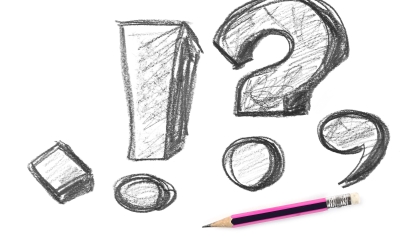To Comma or Not to Comma?
Commas are a necessary part of any academic essay, yet their usage remains elusive to many students and what otherwise might be a strong paper is tarnished by improper comma placement. There is a balance — an art — to using commas and other punctuation. Becoming familiar with how commas are used in writing can greatly assist students in editing their own writing and save time when visiting the Learning Centers.
Separate Clauses: Fragments and Run-Ons
Commas are often erroneously used as separation between independent clauses, or replaced by periods to divide dependent clauses. This results in run-on sentences and sentence fragments, respectively. These errors could easily be fixed by reading one’s paper aloud: If it sounds wrong, it probably is wrong.
In the case of run-ons, often a period is the only edit that is needed — but it is not the only option! Varying sentence lengths with semicolons, dashes, and conjunctions makes a paper more interesting to read.
Look to the example of Gary Provost for inspiration: “This sentence has five words. Here are five more words. Five-word sentences are fine. But several together become monotonous. Listen to what is happening. The writing is getting boring. The ear demands some variety.
If I vary the sentence length, I create music. Music. The writing sings. It has a pleasant rhythm, a lilt, a harmony. I use short sentences. And I use sentences of medium length. And sometimes, when I am certain the reader is rested, I will engage him with a sentence of considerable length, a sentence that burns with energy and builds with all the impetus of a crescendo, the roll of the drums, the crash of the cymbals — sounds that say listen to this, it is important.”
Fragments occur when one has a thought in a paper, but never quite got to finishing it. These can be remedied in much the same manner except one would use various punctuation to attach it to another sentence, instead of dividing sentences.
Comma Use: Too Much, or Too Little
In general, comma use falls into two categories: too much, and too little. In the “too much” category we have errors when students place a comma in front of an integrated phrase:
- Between a subject and predicate: His brilliant mind and curiosity, have left.
- Between the verb and its complement: He mentions, that not knowing how to bring someone back can be a deadly problem.
- Between a noun and an integrated relative clause: The ethnocentric view, that many Americans have, leads to much conflict in the world.
- Between a subordinator and its clause: There was a woman taking care of her husband because, an accident left him unable to work.
- Between a definite generic noun and the name identifying its referent (neither comma is correct here): I went to see the movie, “Midnight in Paris” with my friend, Jessie.
In the “too little” category, students forget to insert a comma to set off a supplementary word or phrase:
- Surrounding a sentence adverb: In many ways however life in a small town is much more pleasant.
- Between a preposed adjunct and the main clause: Using a scooping motion toss it in the air.
- Before a result adjunct: The molecule has one double bond between carbons generating monounsaturated fat.
- Before a contrast adjunct: Their religion is all for equal rights yet they have no freedom.
- Before a supplementary relative clause: There are monounsaturated fatty acids which lack two hydrogen atoms.
- Before a direct quotation: She said “I don’t want to go home.”
The Oxford Comma
The Oxford comma is the comma you use before the word “and” in a list. While there is controversy on whether or not the Oxford — or serial — comma is necessary, it helps clarify what you are trying to say. You want the people who read your paper to understand what you are trying to say, because a lack of clarity may result in ambiguity.
Here is one example of why it would be a good idea to use the Oxford comma.
- With: I had eggs, toast, and orange juice.
- Without: I had eggs, toast and orange juice. (Soggy toast!)
Merrill Perlman, in the Columbia Journalism Review, gives this example: “My favorite sandwiches are pastrami, peanut butter and jelly and cream cheese.”
Because the verb is plural, it’s clear that there are at least two favorite sandwiches. But because there are two “ands,” it’s unclear whether the favorites include “pastrami, peanut butter(,) and jelly,” “peanut butter and jelly,” “jelly and cream cheese,” or “peanut butter and jelly and cream cheese.”
The recommendation to omit the “serial comma” is intended only when no ambiguity would result from it. Here’s how The Associated Press Stylebook puts it:
- Use commas to separate elements in a series, but do not put a comma before the conjunction in a simple series: The flag is red, white and blue. He would nominate Tom, Dick or Harry.
- Put a comma before the concluding conjunction in a series, however, if an integral element of the series requires a conjunction: I had orange juice, toast, and ham and eggs for breakfast.
- Use a comma also before the concluding conjunction in a complex series of phrases: The main points to consider are whether the athletes are skillful enough to compete, whether they have the stamina to endure the training, and whether they have the proper mental attitude.
Accordion Content
-
Steven Pinker’s The Sense of Style

